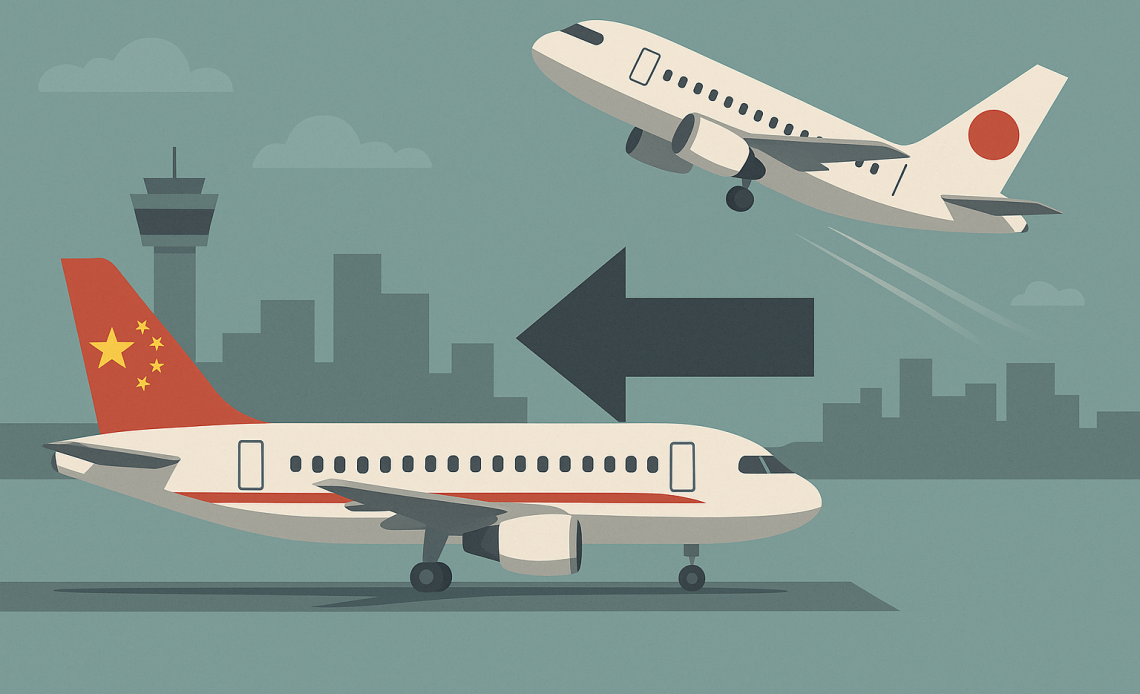
China’s instruction for its airlines to scale back services to Japan through March 2026 is emerging as a decisive response to a sharp collapse in travel demand, reported Bloomberg.
As per the guidance issued last week, the order came soon after comments by Japanese Prime Minister Sanae Takaichi triggered diplomatic tension over Taiwan.
It was also delivered before Donald Trump held back-to-back calls on Monday with Chinese President Xi Jinping and Japan’s new leader, highlighting that the shift in flight planning was not influenced by those discussions.
The length of the reduction, the timing around the seasonal schedule change, and the steep drop in bookings signal a long period of disruption.
China flight cuts follow steep drop in bookings
Beijing asked airlines to reduce flights to Japan “for now,” with flexibility to adjust depending on diplomatic shifts, said the report.
The instruction aligns with the global switch from winter to summer airline schedules at the end of March, a period when capacity normally changes.
Travel from China to Japan had already fallen after Beijing urged citizens to be cautious about visiting.
The order to airlines extends the pullback through the Lunar New Year, one of the busiest periods for Chinese tourists.
Carriers were allowed to choose which routes to trim and how heavily to scale back, indicating that the reduction is broad but not uniform.
Cancellations stretch into 2026 as travellers pause plans
According to China Trading Desk, cancellations by Chinese tourists have now extended into April 2026.
The group, which monitors China’s travel patterns, shows that what began as a sharp year-end drop is now spreading into next year, with many travellers treating the situation as an extended freeze.
Scheduled flights for December from China to Japan are already down sharply from October levels.
Experts expect more than half of existing routes to be cancelled by year’s end.
At least 12 routes linking Shanghai, Guangzhou, and Nanjing with key Japanese destinations such as Nagoya, Fukuoka, and Sapporo have been removed from schedules, with further reductions likely.
The group estimates Japan may lose as much as 1.2 billion dollars in visitor spending by the end of the year.
If cancellations continue at the current pace through 2026, the cumulative loss may reach 9 billion dollars.
Airlines shrink capacity with route cuts and smaller aircraft
China Eastern Airlines faces the largest impact among mainland carriers because it operates close to 16,000 flights a year to Japan.
The fall in bookings has pushed Chinese airlines to make ad hoc weekly schedule changes, adjusting capacity without long-term commitments.
Some carriers have swapped widebody aircraft for smaller narrowbody models to match the lower demand.
Data from AeroRoutes shows frequent adjustments across different cities and weeks, highlighting that airlines are responding to both political pressure and changing travel behaviour.
In parallel, Beijing also launched a seafood import freeze on Japanese products, signalling pressure beyond aviation.
Extended disruption weighs on regional tourism and aviation
The length of the instruction, stretching to the end of March 2026, signals that Beijing expects travel demand to remain weak for an extended period.
With cancellations deep into 2026 and major route cuts already in place, both tourism and aviation between China and Japan are now under significant strain.
The guidance comes as part of broader economic retaliation by China amid rising Japan-Taiwan tensions.
The next major schedule change in March 2026 could provide an opportunity for recovery, but current booking data suggests travel flows may stay suppressed well beyond that mark.
For now, airlines, tourism operators, and related industries are bracing for a long phase of unpredictable planning and continued financial impact.
The post China orders airline pullback as Japan travel demand collapses appeared first on Invezz






